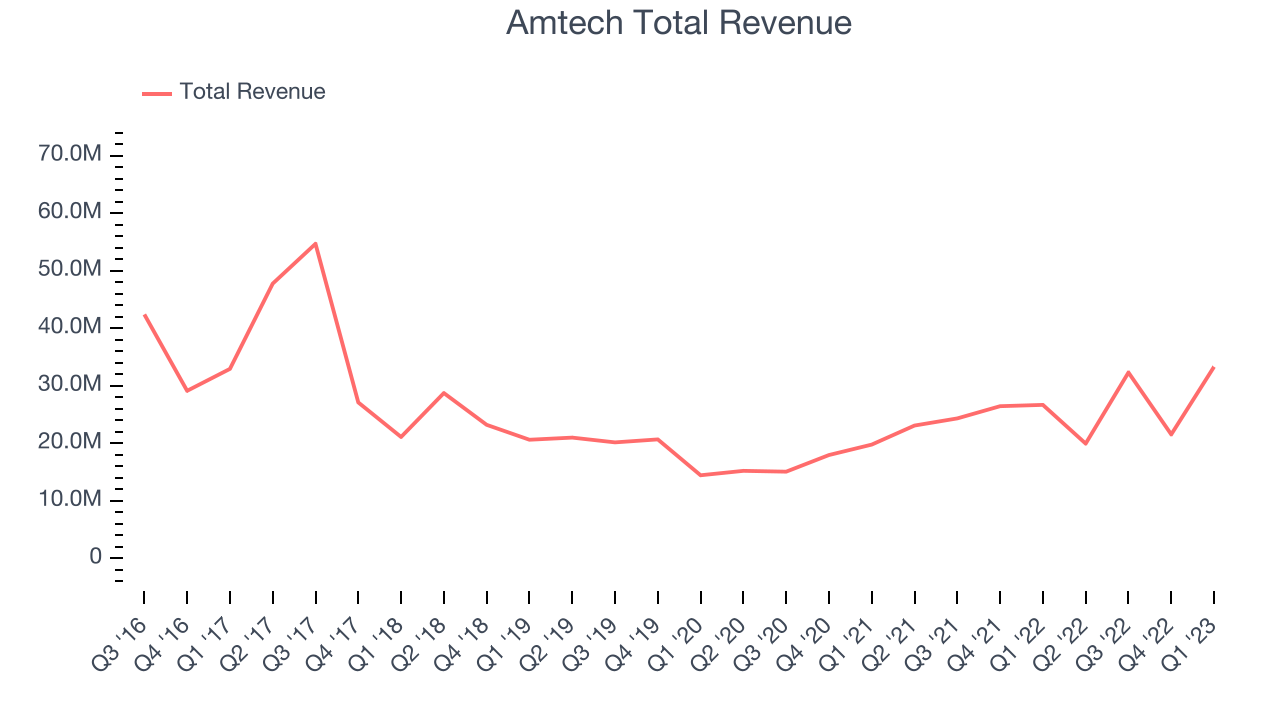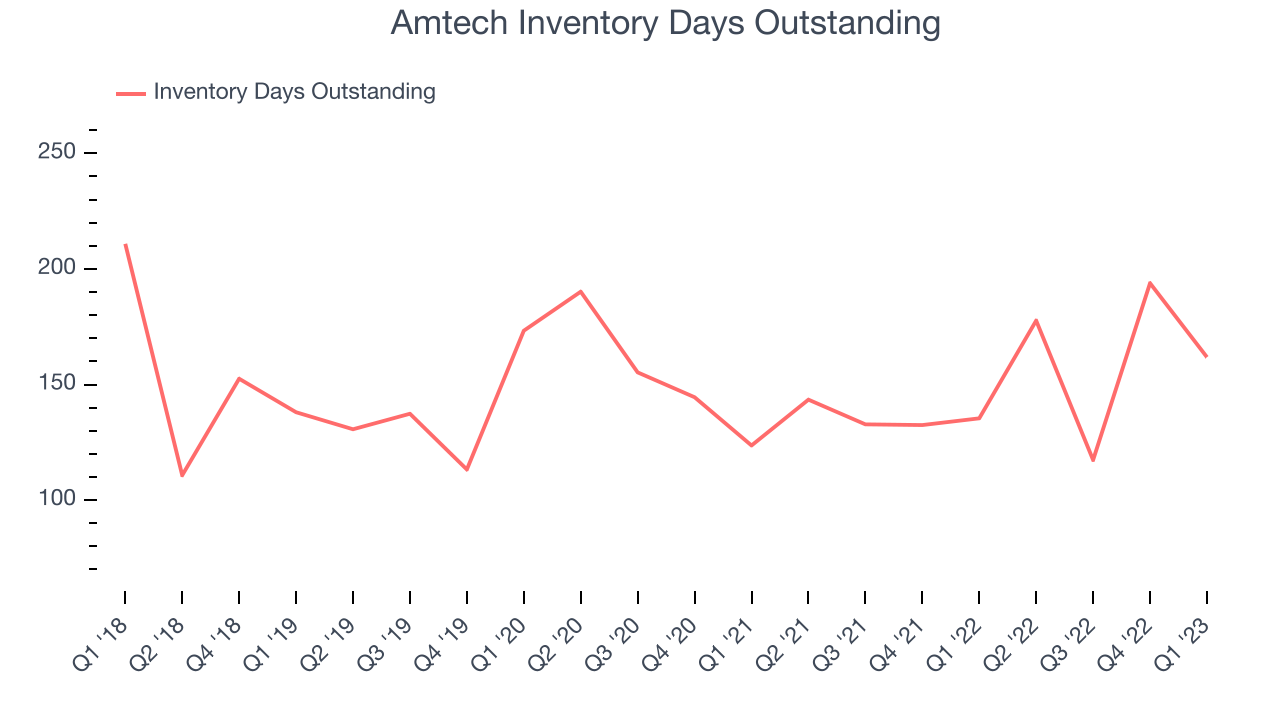Semiconductor production equipment provider Amtech Systems (NASDAQ:ASYS) reported Q2 FY2023 results topping analyst expectations, with revenue up 24.8% year on year to $33.3 million. However, guidance for the next quarter was less impressive, coming in at $32 million at the midpoint, being 5.19% below analyst estimates. Amtech made a GAAP profit of $3.2 million, improving on its profit of $1.97 million, in the same quarter last year.
Is now the time to buy Amtech? Access our full analysis of the earnings results here, it's free.
Amtech (ASYS) Q2 FY2023 Highlights:
- Revenue: $33.3 million vs analyst estimates of $30.8 million (8.33% beat)
- Revenue guidance for Q3 2023 is $32 million at the midpoint, below analyst estimates of $33.8 million
- Free cash flow was negative $3.57 million, compared to negative free cash flow of $2.73 million in previous quarter
- Inventory Days Outstanding: 162, down from 194 previous quarter
- Gross Margin (GAAP): 40.4%, up from 38.6% same quarter last year
“In the second quarter, we achieved $33.3 million in revenue, growing 21% year over year, inclusive of our recent acquisition of Entrepix. Growth in our SiC products, which now represents approximately 40% of total Material & Substrate segment sales, and demand for our high temperature belt furnaces for EV applications, offset the continued softness in the broader semiconductor industry. These strong results demonstrate the resiliency of our product and end market diversification. We believe our strategy to capitalize on multiple, high-growth, megatrend opportunities and efforts on operational optimization are creating a strong and durable foundation in preparation for sustainable value creation,” commented Mr. Michael Whang, Chief Executive Officer of Amtech.
Focusing on Silicon Carbide and Power Semiconductor sectors, Amtech Systems (NASDAQ:ASYS) produces machinery and related chemicals needed for manufacturing semiconductors.
The semiconductor industry is driven by demand for advanced electronic products like smartphones, PCs, servers and data storage. The growth of data and technologies like artificial intelligence, 5G networks and smart cars are also creating a next wave of growth for the industry. To keep up with ever changing customer needs requires new tools that can design, fabricate and test at ever smaller sizes and more complex architectures, and that is driving the demand for semiconductor capital manufacturing equipment.
Sales Growth
Amtech's revenue growth over the last three years has been mediocre, averaging 16% annually. But as you can see below, last year has not been especially strong, with quarterly revenue growing from $26.7 million to $33.3 million. Semiconductors are a cyclical industry and long-term investors should be prepared for periods of high growth, followed by periods of revenue contractions (which can sometimes offer opportune times to buy).

This was a good quarter for Amtech as revenues grew 24.8%, topping analyst estimates by 8.33%. Amtech's revenue growth inflected from negative to positive this quarter, indicating that the recent downturn is likely in the rearview mirror.
Amtech's revenues returned to growth this quarter, and the company is pointing to a return to sustainable growth, with next quarter guided to 60.3% growth year on year and analysts agree, forecasting growth of 37% over the next twelve months.
In volatile times like these we look for robust businesses with strong pricing power. Unknown to most investors, this company is one of the highest-quality software companies in the world, and their software products have been the default standard in critical industries for decades. The result is an impressive business that is up an incredible 18,152% since the IPO. You can find it on our platform for free.
Product Demand & Outstanding Inventory
Days Inventory Outstanding (DIO) are an important metric for chipmakers, as it reflects the capital intensity of the business and the cyclical nature of semiconductor supply and demand. In a tight supply environment, inventories tend to be stable, allowing chipmakers to exert pricing power. Steadily increasing DIO can be a warning sign that demand is weak, and if inventories continue to rise the company may have to downsize production.

This quarter, Amtech’s inventory days came in at 162, 16 days above the five year average, suggesting that despite the recent decrease the inventory levels are still higher than what we used to see in the past.
Key Takeaways from Amtech's Q2 Results
Since it has still been burning cash over the last twelve months it is worth keeping an eye on Amtech’s balance sheet, but we note that with a market capitalization of $126.2 million and more than $17.7 million in cash, the company has the capacity to continue to prioritise growth over profitability.
We were very impressed by the strong improvements in Amtech’s inventory levels. And we were also excited to see that it outperformed Wall St’s revenue expectations, although there was a $6.3mm revenue contribution from an acquisition. It is unclear how many sellside analysts modeled the magnitude and timing of this deal correctly, so the beat may be less impressive than the headline. On the other hand, it was unfortunate to see that the revenue guidance for the next quarter missed analysts' expectations and operating margin deteriorated. Zooming out, we think this was still a decent, albeit mixed, quarter, showing the company is staying on target. The company is up 2.04% on the results and currently trades at $9 per share.
Should you invest in Amtech right now? It is important that you take into account its valuation and business qualities, as well as what happened in the latest quarter. We look at that in our actionable report which you can read here, it's free.
One way to find opportunities in the market is to watch for generational shifts in the economy. Almost every company is slowly finding itself becoming a technology company and facing cybersecurity risks and as a result, the demand for cloud-native cybersecurity is skyrocketing. This company is leading a massive technological shift in the industry and with revenue growth of 70% year on year and best-in-class SaaS metrics it should definitely be on your radar.
The author has no position in any of the stocks mentioned.
